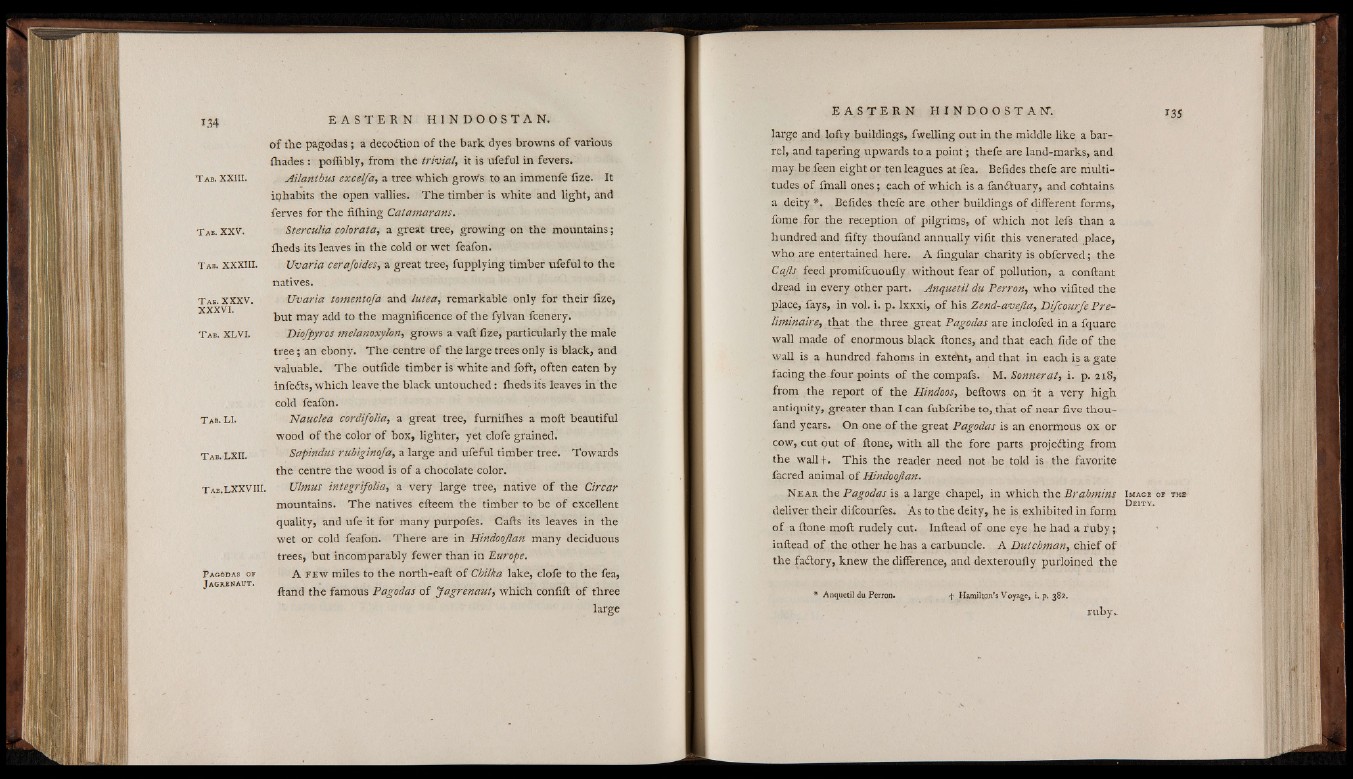
T ab. XXIII.
T ab. X X V .
T ab. X X X III.
T a b . X X X V .
X X X V I .
T a b . X L V I .
T ab. L I .
T ab. LX II.
T a b .L X X V I I I .
P agodas of
J ag r en au t .
o f the pagodas ; a decoition of the bark dyes browns o f various
{hades : poifibly, from the trivial, it is ufeful in fevers.
Ailanthus excel/a, a tree which grows to an immenfe fize. It
inhabits the open vallies. The timber is white and light, and
ferves for the filhing Catamarans.
Sterculia colorata, a great tree, growing on the mountains;
iheds its leaves in the cold or wet feafon.
Uvaria cerafoides, a great tree, fupplving timber ufeful to the
natives.
Uvaria tomentofa and lutea, remarkable only for their fize,
but may add to the magnificence of the fylvan fcenery.
Diofpyros melanoxylon, grows a vait fize, particularly the male
tree; an ebony. The centre of the large trees only is black, and
valuable. The outfide timber is white and foft, often eaten by
infeCts, which leave the black untouched: iheds its leaves in the
cold feafon.
Nauclea cordifolia, a great tree, furniihes a moft beautiful
wood of the color o f box, lighter, yet clofe grained.
Sapindus rubiginofa, a large and ufeful timber tree. Towards
the centre the wood is o f a chocolate color.
Ulmus integrifolia, a very large tree, native o f the Circar
mountains. The natives efteem the timber to be of excellent
quality, and ufe it for many purpofes. Cafts its leaves in the
wet or cold feafon. There are in Hindoo/lan many deciduous
trees, but incomparably fewer than in Europe.
A f e w miles to the north-eaft of Chilka lake, clofe to the fea,
ftand the famous Pagodas of Jagrenaut, which confift of three
large
large and lofty buildings, fwelling out in the middle like a barrel,
and tapering upwards to a point; thefe are land-marks, and
may be feen eight or ten leagues at fea. Befides thefe are multitudes
of fmall ones; each of which is a fanCtuary, and cohtains
a deity *. Befides thefe are other buildings of different forms,
fome for the reception of pilgrims, o f which not lefs than a
hundred and fifty thoufand annually vifit this venerated .place,
who are entertained here. A Angular charity is obferved; the
Cafts feed promifcuouily without fear of pollution, a conftant
dread in every other part. Anquetil du Perron, who vifited the
place, fays, in vol. i. p. lxxxi, o f his Zend-avejia, Difcourfe Pre-
liminaire, that the three great Pagodas are inclofed in a fquare
wall made o f enormous black ftones, and that each fide o f the
wall is a hundred fahoms in exteht, and that in each is a gate
facing the four points of the compafs. M. Sonnerat, i. p. ai8,
from the report of the Hindoos, bellows on it a very high
antiquity, greater than I can fubfcribe to, that o f near five thoufand
years. On one o f the great Pagodas is an enormous ox or
cow, cut out of itone, with all the fore parts projecting from
the wallt. This the reader need not be told is the favorite
facred animal of Hindoojlan.
N e a r the Pagodas is a large chapel, in which the Brahmins
deliver their difcourfes. As to the deity, he is exhibited in form
o f a itone moft rudely cut. Inftead of one eye he had a ru b y ;
initead o f the other he has a carbuncle. A Dutchman, chief o f
the faCtory, knew the difference, and dexterouily purloined the
Image of thb
D e i t y .
* Anquetil du Perron. \ Hamilton’ s Voyage, i. p. 382.
ruby.